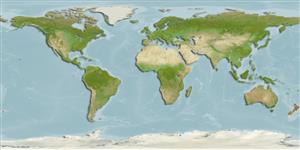>
Blenniiformes (Blennies) >
Tripterygiidae (Triplefin blennies) > Tripterygiinae
Etymology: Cryptichthys: Greek, kryptos = hidden + Greek, ichthys = fish (Ref. 45335); jojettae: Named after Jojette Drost, former staff member of the National Museum (New Zealand), collector of the paratypes of this species..
Environment: milieu / climate zone / depth range / distribution range
Ecologia
marinhas demersal; intervalo de profundidade 0 - 12 m (Ref. 13227). Temperate
Southwest Pacific: endemic to New Zealand.
Tamanho / Peso / Idade
Maturity: Lm ? range ? - ? cm
Max length : 6.0 cm TL macho/indeterminado; (Ref. 9003)
Descrição suscinta
Chaves de identificação | Morfologia | Morfometria
Espinhos dorsais (total) : 18 - 21; Raios dorsais (total) : 9 - 11; Espinhos anais: 0; Raios anais : 20 - 22. Head and body red to reddish brown with pinkish blotches and prominent dark columns and arches running onto belly. Fins of various hues of pink and red. Distinguished from other triplefins by the distinctive color pattern and the continuous lateral line extending to the caudal peduncle.
Adults inhabit rock pools and in surge zones, especially in exposed areas. Usually on steep slopes or sides of boulders encrusted with invertebrates and algae (Ref. 13227). Eggs are hemispherical and covered with numerous sticky threads that anchor them in the algae on the nesting sites (Ref. 240). Larvae are planktonic which occur primarily in shallow, nearshore waters (Ref. 94114).
Ciclo de vida ou comportamento de acasalamento
Maturities | Reprodução | Spawnings | Egg(s) | Fecundities | Larvas
Fricke, R., 1994. Tripterygiid fishes of Australia, New Zealand and the southwest Pacific Ocean (Teleostei). Theses Zool. 24:1-585. (Ref. 13227)
Status na Lista Vermelha da UICN (Ref. 130435)
Ameaça para os humanos
Harmless
Uso pelos humanos
Pescarias: sem interesse
Ferramentas
Relatórios especiais
Baixar XML
Fontes da internet
Estimates based on models
Preferred temperature (Ref.
123201): 11.9 - 18.5, mean 15.9 °C (based on 131 cells).
Índice de diversidade filogenética (Ref.
82804): PD
50 = 1.0000 [Uniqueness, from 0.5 = low to 2.0 = high].
Bayesian length-weight: a=0.00676 (0.00364 - 0.01255), b=3.09 (2.92 - 3.26), in cm total length, based on LWR estimates for this species & (Sub)family-body (Ref.
93245).
Nível Trófico (Ref.
69278): 3.2 ±0.4 se; based on size and trophs of closest relatives
Resiliência (Ref.
120179): Elevada, tempo mínimo de duplicação da população menor que 15 meses (Preliminary K or Fecundity.).
Fishing Vulnerability (Ref.
59153): Low vulnerability (10 of 100).
Nutrients (Ref.
124155): Calcium = 283 [143, 976] mg/100g; Iron = 1.08 [0.47, 2.38] mg/100g; Protein = 17.9 [16.4, 19.4] %; Omega3 = 0.409 [0.136, 1.260] g/100g; Selenium = 14 [4, 46] μg/100g; VitaminA = 9.64 [1.63, 56.15] μg/100g; Zinc = 1.7 [0.9, 3.0] mg/100g (wet weight);
